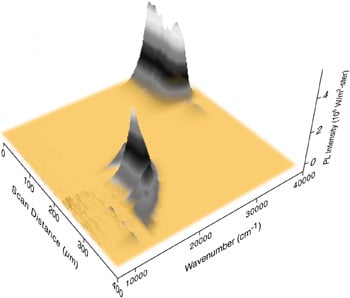Photoluminescence Spectroscopy
NLR's capabilities in photoluminescence spectroscopy include excitation wavelengths that allow for varying levels of volume excitation; a detection range extending from 0.4 to 2.7 µm; sample temperatures of 4 K to 300 K; and mapping capabilities with 1- to 2-µm spatial resolution on the Fourier-transform-based system.
Photoluminescence spectroscopy is a contactless, nondestructive method to probe the electronic structure of materials.
Material Properties
The intensity and spectral content of the emitted photoluminescence is a direct measure of important material properties, including:

NLR researchers use scanning Fourier transform photoluminescence microspectroscopy to produce three-dimensional maps to determine the composition and quality of grown absorber materials
- Bandgap determination
The spectral distribution of photoluminescence spectroscopy from a semiconductor can be analyzed to nondestructively determine the electronic bandgap. This provides a means to quantify the elemental composition of compound semiconductor and is a vitally important material parameter influencing solar cell device efficiency. - Impurity levels and defect detection
The photoluminescence spectroscopy spectrum at low sample temperatures often reveals spectral peaks associated with impurities contained within the host material. The high sensitivity of this technique provides the potential to identify extremely low concentrations of intentional and unintentional impurities that can strongly affect material quality and device performance. - Recombination mechanisms
The quantity of photoluminescence spectroscopy emitted from a material is directly related to the relative amount of radiative and nonradiative recombination rates. Nonradiative rates are typically associated with impurities and, thus, this technique can qualitatively monitor changes in material quality as a function of growth and processing conditions.
Contact
Share
Last Updated Dec. 6, 2025
